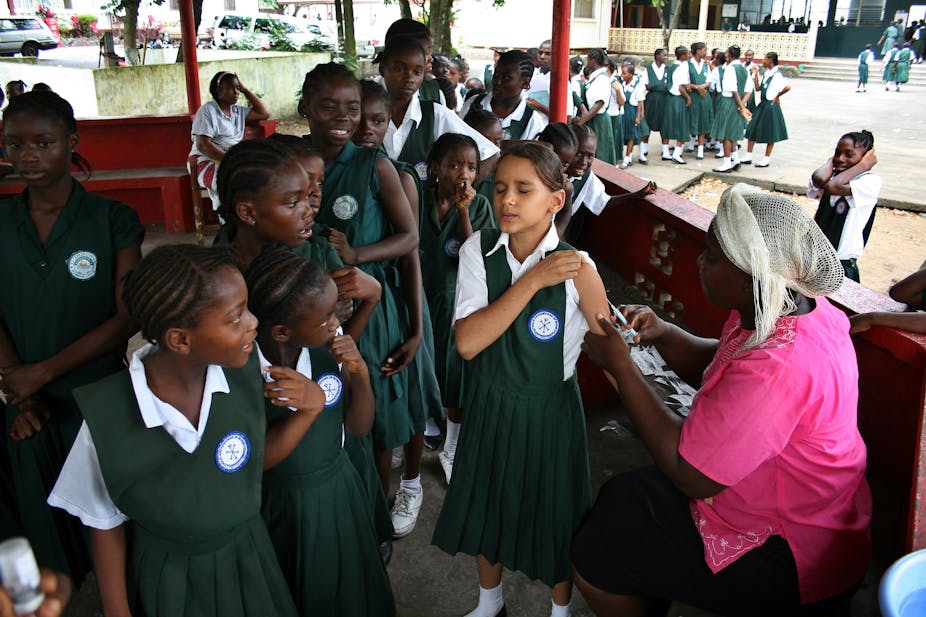Most children in sub-Saharan Africa are today entitled to vaccines against 10 different diseases. While this is notably fewer than in high-income countries – British children are vaccinated against 13 diseases, for example – substantial progress has been made in the past few decades in protecting children in the developing world. The World Health Organisation estimates that immunisation prevents between 2m and 3m deaths every year.
However, millions of people remain at risk of some of the world’s most threatening diseases, including malaria, tuberculosis and HIV/AIDS. Effective vaccines against these conditions would be in extraordinary demand in the developing world. But most vaccines offered today were originally developed by global pharmaceutical companies for markets in the West, which still control the direction of most vaccine development.
An article published by the Royal Society this week argues that the vaccine industry lacks incentives to invest in developing vaccines for diseases with no market in the Western world. The authors, Michèle Barocchi and Rino Rappuoli, who both work for the pharmaceutical firm Novartis, call for a more significant global effort to change this situation:
These efforts include a clear policy, global co-ordination of funds dedicated to the development of neglected disease and an agreement on regulatory strategies and incentives for the private sector.
Unfortunately, their arguments are not clearly articulated and the article puts forward no new ideas while ignoring existing strategies that show signs of success.
Market solutions
The global vaccine market is largely divided between numerous Indian manufacturers and global pharmaceutical companies headquartered in the West, such as GSK, Sanofi Pasteur, Novartis, Merck and Pfizer. As shown in a recent report by Medecins Sans Frontieres, vaccines from Indian manufacturers are generally substantially cheaper than those sold by the global companies.
Until the creation of Gavi, an alliance of public and private sector organisations, in the year 2000, vaccines developed by global pharmaceutical firms were generally only distributed in high-income countries. Older vaccines, such as those for measles and polio, were bought for less than a dollar per child, primarily from Indian manufacturers.
Gavi has since raised more than US$9 billion (£5.8 billion) from donors and philanthropists and spends most of its funds on introducing vaccines into the poorest countries in the world. With the new vaccines, including Haemophilus influenzae type b, rotavirus and pneumococcal vaccines, the price of fully vaccinating a child has increased to around US$30 (£19).

In their article, Barocchi and Rappuoli put forward Gavi’s Advanced Market Commitment and the Health Impact Fund as novel, promising solutions to addressing the lack of incentives for developing vaccines for low-income countries. These are two similar concepts but neither of them are particularly new nor have they yet been proven to work.
The concept of the advanced market commitment uses the idea that a group of governments would give a binding commitment to purchase a specified vaccine product at a pre-set price. This would then create an incentive for vaccine manufacturers to develop it.
However, this commitment has so far only been used with the pneumococcal conjugate vaccine, which was already in late stages of development by two global pharmaceutical companies when the initiative was launched. To my knowledge, no other advanced market commitment has since been implemented.
The Health Impact Fund, first suggested in 2010, is a proposed global agency where pharmaceutical companies can register new medicines before they are developed. A firm would agree to provide the future drug at cost anywhere it is needed and, instead of profits, would receive additional funds depending on the actual global health impact of the drug. The greater the health impact, the greater the reward.
However, accurately estimating the health impact in terms of disease and death reduction is extremely challenging in countries with weak disease monitoring infrastructure. And the cost of development and production of pharmaceuticals are normally confidential. These are probably some of the reasons why the concept has remained on the drawing board.
Creating incentives
It is puzzling that Barocchi and Rappuoli do not seek to highlight recent success stories in vaccine development based on other forms of public-private partnership and build on these for future recommendations.
For example, a major leap forward was seen in 2010 when a new meningitis vaccine solely developed for African strains came to market. The vaccine was developed by the Indian Serum Institute, which promised not to charge more than US$0.50 (£0.32) per dose after the Bill and Melinda Gates Foundation agreed to fund the development work. The vaccine has since been bought by Gavi and reached more than 217m people.
This success is proof that public/charitable development funding can work, although there are some caveats. The meningitis triumph is closely related to the fact that comparable vaccines had already been developed, which considerably eased the clinical process. And while substantial funding has been granted for development of vaccines against HIV/AIDS and TB, the technical challenges are enormous and no vaccine candidates against these diseases are yet in late-stage development.
However, there is no doubt that continuous vaccine procurement by Gavi over the past 15 years has increased the confidence of manufacturers to invest in development. For example, since Gavi started purchasing the combination vaccine containing Haemophilus influenzae type b in 2000, the number of manufacturers of the vaccine has increased from one to four and the price per dose has decreased by 40%.
The existence of Gavi has brought important understandings about the incentives needed for vaccine manufacturers to invest. During the Ebola epidemic, three global pharmaceutical companies rapidly began development of a vaccine, which is unprecedented for a neglected, tropical disease. By showing that they are willing to finance vaccines for the poorest countries over the long term, development partners have helped to increase the trust of vaccine manufacturers in a viable market for these products.

